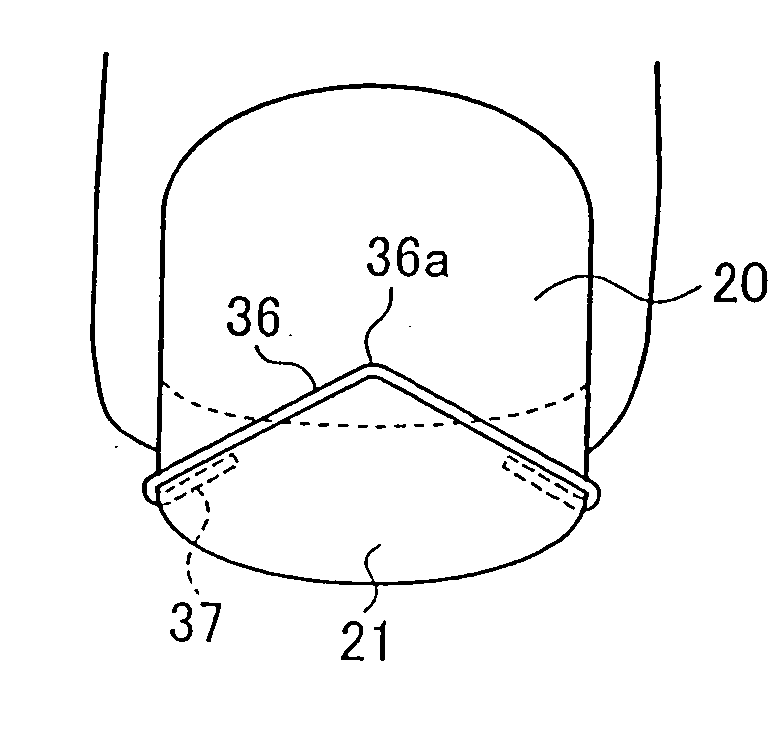Corrective Device for Deformed Nails
a technology for corrective devices and nails, applied in the field of correction, can solve problems such as pain for patients, difficulty in wearing and releasing nails by themselves, and the end of the corrective device in the width direction of nails is likely to curl and peel, so as to increase the deformation stress and increase the shape memory ability
- Summary
- Abstract
- Description
- Claims
- Application Information
AI Technical Summary
Benefits of technology
Problems solved by technology
Method used
Image
Examples
example 1
[0048]A hooked claw 6 (FIG. 2) and a nail stopping part 2 of a simple hook (FIG. 1) with length of 3 mm was formed on a short rectangular strip with length of 6.4 mm and width of 2.2 mm cut out from an SUS 304 stainless steel plate with thickness of 0.2 mm in order to compare the effect of a double fold and a simple hook on correction ability for deformed nails and a holding force of a nail. A curvature radius of bending from a corrective plate 1 was made to be approximately 0.475 mm in both the hooked claw 6 and the nail stopping part 2, and a gap between the nail stopping part 2 and the correction plate 1 and a gap between a folding part 4 and the correction plate 4 were chosen to be 0.95 mm, respectively.
[0049]Using an aluminum plate with plate thickness of 1.02 mm as a virtual nail, the edge of the aluminum plate was sandwiched between a correction plate 1 and a hooked claw 6 or between a correction plate 1 and a nail stopping part 2, respectively, to measure a load of pulling o...
example 2
[0063]A SUS 304 stainless steel cold-rolled steel plate with thickness of 0.8 mm was punched out to collect an elastic metal strip 10 (FIG. 3) with four tongue strips 11 with width of 1.5 mm and length of 5 mm protruded from the one edge of a correction plate 16 with a size of 22 mm×3 mm. After the tip of tongue strip 11 was bent, the tongue strip 11 was further bent at the location 1 mm from the end of the correction plate 16 to form a hooked claw 17 with a double structure of a folding part 18 and a bending part 19.
[0064]The product was next heat-treated in a red hot condition at 500° C. for 30 minutes, followed by water hardening to remove stress and strain introduced in the bending process as well as improve hardness, consequently elasticity of a corrective device 15.
[0065]A manufactured corrective device for a deformed nail 15, was applied to ten subjects to investigate the progress of correcting ingrown nails. A degree of correction was varied with subjects, but the effect of ...
example 3
[0071]A SUS 304 stainless steel cold-draw wire rod with wire diameter of 0.7 mm was cold-rolled to thickness of 0.4 mm to collect a wrought wire rod with length of 28 mm. Both ends of a correction part 36 were bent, followed by further bending at a location 2 mm from the tip of the fold to form a hooked claw 37 with a double structure of a folding part 38 and a bending part 39, which was finally bent in a dogleg shape with an open angle of 120 degrees, forming the shape in FIG. 10. The product after processing was heat-treated in a red hot condition at 500° C. for 30 minutes, followed by water hardening to remove stress and strain introduced in the bending process, as well as to improve hardness and consequently elasticity of a corrective device 35.
[0072]A manufactured corrective device for a deformed nail 35 was applied to ten subjects to investigate the progress of correcting ingrown nails. A degree of correction was varied with subjects, but the effect of correction was observed ...
PUM
| Property | Measurement | Unit |
|---|---|---|
| thickness | aaaaa | aaaaa |
| width | aaaaa | aaaaa |
| length | aaaaa | aaaaa |
Abstract
Description
Claims
Application Information
 Login to View More
Login to View More - R&D
- Intellectual Property
- Life Sciences
- Materials
- Tech Scout
- Unparalleled Data Quality
- Higher Quality Content
- 60% Fewer Hallucinations
Browse by: Latest US Patents, China's latest patents, Technical Efficacy Thesaurus, Application Domain, Technology Topic, Popular Technical Reports.
© 2025 PatSnap. All rights reserved.Legal|Privacy policy|Modern Slavery Act Transparency Statement|Sitemap|About US| Contact US: help@patsnap.com



